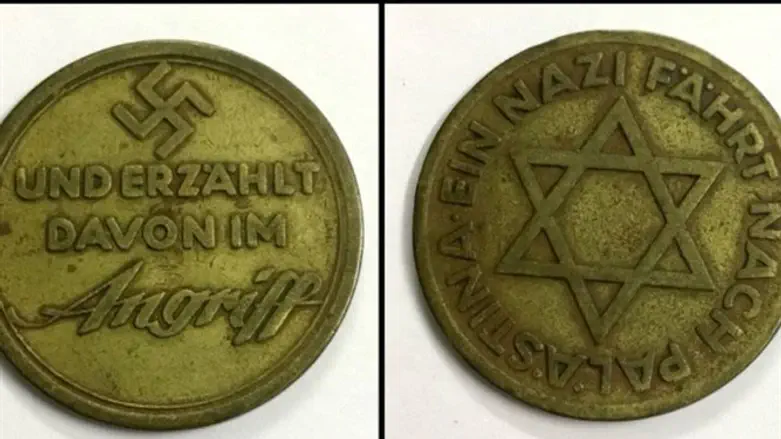
An auction will take place on Wednesday night at CollecTodo on the Bidspirit auction house's website, in which rare and fascinating items from the Holocaust period will be sold. These artifacts shed light on events of those years from various angles: the Nazi party, the Kastner trial, prayers for the rescue of the Jews, and more.
Among other things, a rare medal from 1934 called "Nazi in Palestine" will be sold: A medal minted on the occasion of a series of articles "A Nazi goes to Palestine" published in the Nazi journal Der Angriff ("The Attack"). The medal is a memento of cooperation between the Nazi Party and the German Zionist Association, in favor of the joint goal of bringing German Jews to Palestine (the "transfer").
The center of one side sports a Star of David surrounded by the German caption "A Nazi going to Palestine" (Ein Nazi fährt nach Palästina). In the center of the other side is a swastika and the caption "and writes about it in Angriff" (Und erzählt davon in Angriff).
At the beginning of the period of Nazi rule in Germany, the Zionist movement tended to cooperate with the line taken by the Nazi regime at the beginning of its path - encouraging German Jewish immigration to Palestine. In the spring of 1933, the Union of German Zionists decided to contact elements within the Nazi party that might support the Zionist cause.
Kurt Tuchler, a German-Jewish jurist and judge who was a member of the German Zionist Association, appealed to Leopold von Mildenstein, head of the Jewish department of the SD (Nazi and SS Security Service), and asked him to write about the Jewish community in Palestine. In 1933 the two traveled together to Israel with their wives for a month, in order to allow von Mildenstein to be impressed by the flourishing Zionist enterprise.
On his return to Germany, von Mildenstein published a series of twelve articles accompanied with photographs about his tour of Palestine in the Nazi journal Der Angriff, the organ of Nazi propaganda minister Joseph Goebbels. The articles bore the title "A Nazi goes to Palestine." Goebbels issued the medal on the occasion of the article series.
Another exciting item to be sold is an emotional prayer for the rescue of the Jews composed by Rabbi Isaac Halevi Herzog, who served as Chief Rabbi during the time of the Holocaust, which he prayed together with the Emrei Emet, the Rebbe of Gur, in Jerusalem's Hurva Synagogue.
The item is entitled "The Memorial Service for the Day of the Great Fast" - a special prayer written in Jerusalem, 5703 (1943) about the "hundreds of thousands of Israel" who perished at the beginning of the Holocaust.
In addition, a letter will be auctioned off that proposed a plan for the "purchase" of European Jews from the Nazis and was addressed to Rabbi Isaac Halevi Herzog, who served as head of the Yeshivot Committee at the time. The letter was sent by one Baruch Ben Zvi, apparently a Jew who fought in the British army, and begins with a description of European Jewry's situation. The remainder of the letter unveils an action plan for "acquiring" the Jews of Germany being exterminated.
A cap of a kapo, a prisoner who was appointed by the Nazis to supervise other prisoners with a Star of David and captions, is also offered for sale.
Another fascinating and unique item is an original watercolor painting from the Theresienstadt concentration camp from 1943: It is a realistic painting of a doctor's visit to the hospital in Terezin. Both the doctor and the nurse wear yellow patches. The scene was drawn by a man who lived in the Jewish ghetto of the Terezin concentration camp. It shows a section of one of the large halls with the Arabesque architecture typical of Ottoman building in Terezin, which during the 19th century housed the soldiers who protected Prague during the Austro-Hungarian-Prussian War.
In the late 1930s this building became the center of the concentration camp's Jewish ghetto. 155,000 Jews passed through Terezin during the Holocaust, with a very high concentration of intellectuals, artists, and celebrities. They were encouraged and even forced to continue to create visual art, music, and literature in the ghetto.
There was even an active football league in the camp. 33,000 Jews died in the camp and most of the others were sent to other extermination camps. The work is mounted on a black page, glazed and set in a gilded frame.